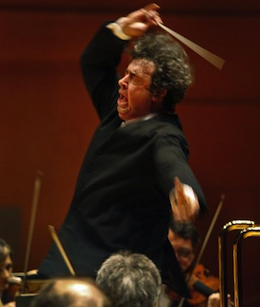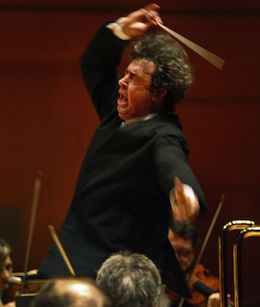
It was altogether fitting — perhaps too much so, from the musicians’ point of view — that the San Francisco Symphony had all those climate conditions to simulate in Richard Strauss’ An Alpine Symphony this week.
Fresh from a tour that ended with tornado-scrambled travel home from the Midwest, the orchestra encountered more weather-related woes on the way to Weill Hall on the Sonoma State campus Thursday night. High winds knocked a tree onto a car on Highway 101 in Petaluma, stalling both the north-bound players and presumably a share of the audience in horrendous traffic. The concert started a half-hour late, with many empty seats in the house.
At the risk of reading too much into external circumstances, the orchestra did tear into the “Thunderstorm and Tempest” scene in Strauss’ 1915 tone poem with particular, possibly cathartic fury. The timpani thundered fearsomely. The strings sent slashing rain squalls across the landscape. The brasses sounded their steely alarm. Even the wind machine, part of the composer’s mighty arsenal, could barely be heard over the torrent of musical noise.
It was an impressive display, an arresting and full-throated sonic assault, vividly set off by the woodwinds’ splatty drips and the slow, sweet emergence of their avian burbling after the worst had passed. You could hear the sunlight filtering through wet leaves.
Such were the pleasures, and there were many, in this colorful performance under guest conductor Semyon Bychkov’s hand. A variety of the work’s big painterly gestures came off splendidly. The strings swooped and veered, capered wittily, and produced a haunting glassy sound for the “On the Glacier” passage. The woodwinds displayed plenty of distinctive character, with special high honors to clarinetist Carey Bell and guest oboist Erik Behr. The horns, led by Robert Ward, played with warmth and dynamism, onstage and off.
The woodwinds displayed plenty of distinctive character, with special high honors to clarinetist Corey Bell and oboist Jonathan Fisher. The horns, led by Robert Ward, played with warmth and dynamism, onstage and off.
Engaging as many of the scenes were, the Alpine also had its share of fuzzy strokes. Entrances and cut offs were not always clean. Balance was a recurring problem, with the strings buried under mountains of brassy sound. Several high-volume sections turned muddy or shrill. The ending came off tentatively.
The Weill auditorium’s airy realm of slatted wood may have posed acoustic challenges. Advised by several veteran listeners to move farther back in the house for the Strauss (a Mozart piano concerto opened the program), this first-time visitor to the hall abandoned a tenth-row seat for one 15 or so rows back after intermission. Even from that distance, the sound in such a big piece as this had a certain dense, compressed feel to it. The effects of spaciousness, of depths and wide vistas were not as apparent as they be in Davies Symphony Hall.
Technical musings aside, Strauss 52-minute excursion into nature demands more of a listener than it finally rewards. At once distinctively episodic and diffuse, the piece keeps inviting the listener to conjure this scene or that — forest and waterfall, “On Flowering Meadows” and “Through Thickets and Undergrowth on False Paths” — without making a very convincing case for the journey’s deeper purpose. It was often exciting without every being truly dramatic. All those instruments and that enveloping sound, you couldn’t help thinking, for a long hike through the hills.
Whatever difficulties the hall may have posed for the Alpine, it couldn’t have been more accommodating to Mozart’s Piano Concerto No. 24 in C Minor. With Till Fellner as the graceful if overly reticent soloist, the ensemble sound was warm, intimate and cohesive. Balance and transparency went hand in hand.
Fellner and the band got off to a gratifying start. Voicing the opening subject with a perfectly decanted blend of elegance and gently probing inquisitiveness, the soloist seemed both serene and subliminally charged. Fellner built some sturdy arpeggiated spans in the development section and played like an athlete who seems to slow down the game to his own pace. Nothing was hurried or hasty, everything carefully considered and built.
Yet it was that very deliberateness that gradually leached energy away. The subliminal got submerged. The second movement, which always risks blandness, didn’t escape that trap in this mild reading. The finale, a set of theme and variations, was often lovely but too level overall.
Bychkov elicited some choice details from the orchestra, as he did in the Strauss, but it wasn’t enough to create memorable reading of K. 491. And yet it was a pleasure all the same, a patch of steady warm sunlight away from whatever the winds were whipping up outside.

